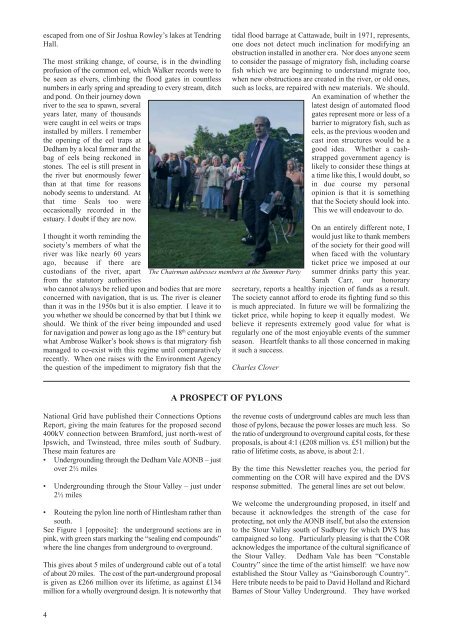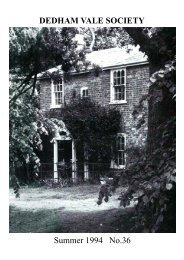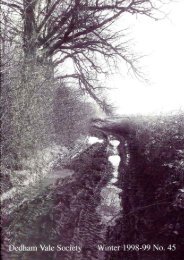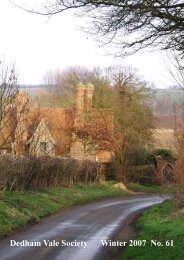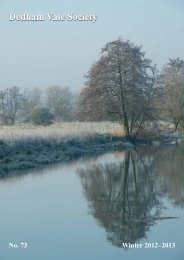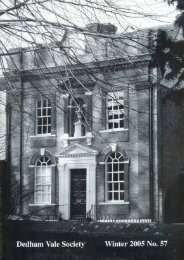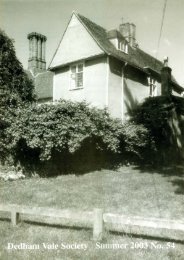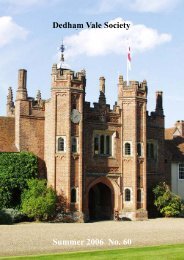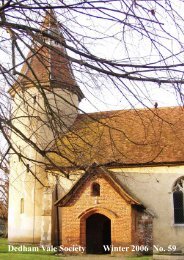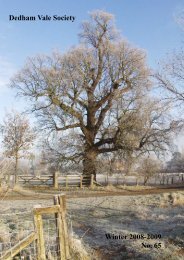Create successful ePaper yourself
Turn your PDF publications into a flip-book with our unique Google optimized e-Paper software.
escaped from one of Sir Joshua Rowley’s lakes at TendringHall.The most striking change, of course, is in the dwindlingprofusion of the common eel, which Walker records were tobe seen as elvers, climbing the flood gates in countlessnumbers in early spring and spreading to every stream, ditchand pond. On their journey downriver to the sea to spawn, severalyears later, many of thousandswere caught in eel weirs or trapsinstalled by millers. I rememberthe opening of the eel traps at<strong>Dedham</strong> by a local farmer and thebag of eels being reckoned instones. The eel is still present inthe river but enormously fewerthan at that time for reasonsnobody seems to understand. Atthat time Seals too wereoccasionally recorded in theestuary. I doubt if they are now.I thought it worth reminding thesociety’s members of what theriver was like nearly 60 yearsago, because if there arecustodians of the river, apartfrom the statutory authoritieswho cannot always be relied upon and bodies that are moreconcerned with navigation, that is us. The river is cleanerthan it was in the 1950s but it is also emptier. I leave it toyou whether we should be concerned by that but I think weshould. We think of the river being impounded and usedfor navigation and power as long ago as the 18 th century butwhat Ambrose Walker’s book shows is that migratory fishmanaged to co-exist with this regime until comparativelyrecently. When one raises with the Environment Agencythe question of the impediment to migratory fish that theThe Chairman addresses members at the Summer Partytidal flood barrage at Cattawade, built in 1971, represents,one does not detect much inclination for modifying anobstruction installed in another era. Nor does anyone seemto consider the passage of migratory fish, including coarsefish which we are beginning to understand migrate too,when new obstructions are created in the river, or old ones,such as locks, are repaired with new materials. We should.An examination of whether thelatest design of automated floodgates represent more or less of abarrier to migratory fish, such aseels, as the previous wooden andcast iron structures would be agood idea. Whether a cashstrappedgovernment agency islikely to consider these things ata time like this, I would doubt, soin due course my personalopinion is that it is somethingthat the <strong>Society</strong> should look into.This we will endeavour to do.On an entirely different note, Iwould just like to thank membersof the society for their good willwhen faced with the voluntaryticket price we imposed at oursummer drinks party this year.Sarah Carr, our honorarysecretary, reports a healthy injection of funds as a result.The society cannot afford to erode its fighting fund so thisis much appreciated. In future we will be formalizing theticket price, while hoping to keep it equally modest. Webelieve it represents extremely good value for what isregularly one of the most enjoyable events of the summerseason. Heartfelt thanks to all those concerned in makingit such a success.Charles CloverA PROSPECT OF PYLONSNational Grid have published their Connections OptionsReport, giving the main features for the proposed second400kV connection between Bramford, just north-west ofIpswich, and Twinstead, three miles south of Sudbury.These main features are• Undergrounding through the <strong>Dedham</strong> <strong>Vale</strong> AONB – justover 2½ miles• Undergrounding through the Stour Valley – just under2½ miles• Routeing the pylon line north of Hintlesham rather thansouth.See Figure 1 [opposite]: the underground sections are inpink, with green stars marking the “sealing end compounds”where the line changes from underground to overground.This gives about 5 miles of underground cable out of a totalof about 20 miles. The cost of the part-underground proposalis given as £266 million over its lifetime, as against £134million for a wholly overground design. It is noteworthy thatthe revenue costs of underground cables are much less thanthose of pylons, because the power losses are much less. Sothe ratio of underground to overground capital costs, for theseproposals, is about 4:1 (£208 million vs. £51 million) but theratio of lifetime costs, as above, is about 2:1.By the time this Newsletter reaches you, the period forcommenting on the COR will have expired and the DVSresponse submitted. The general lines are set out below.We welcome the undergrounding proposed, in itself andbecause it acknowledges the strength of the case forprotecting, not only the AONB itself, but also the extensionto the Stour Valley south of Sudbury for which DVS hascampaigned so long. Particularly pleasing is that the CORacknowledges the importance of the cultural significance ofthe Stour Valley. <strong>Dedham</strong> <strong>Vale</strong> has been “ConstableCountry” since the time of the artist himself: we have nowestablished the Stour Valley as “Gainsborough Country”.Here tribute needs to be paid to David Holland and RichardBarnes of Stour Valley Underground. They have worked4


